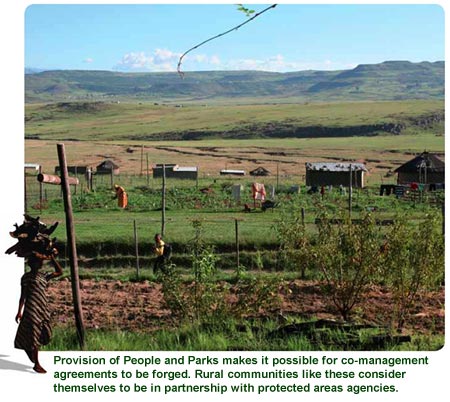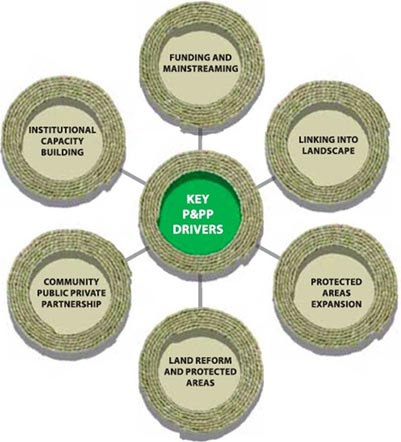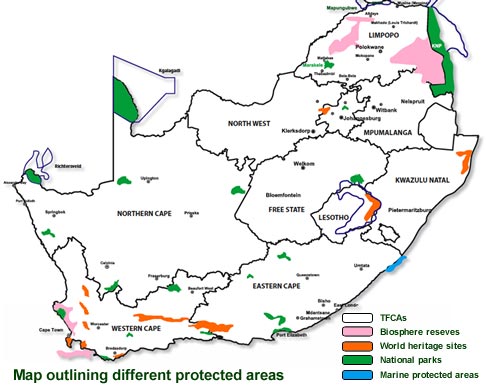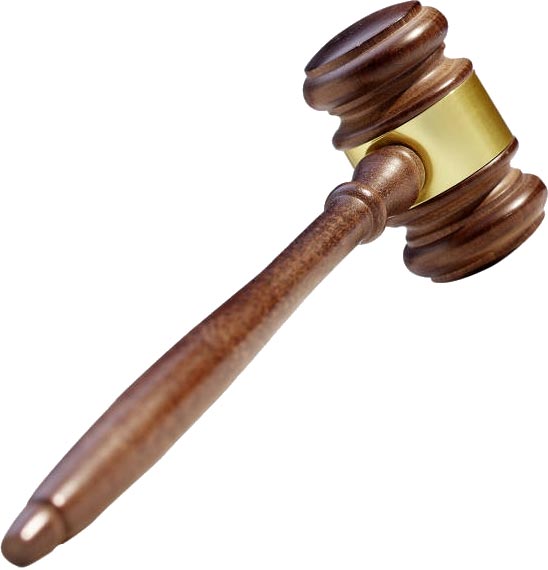About People and Parks Programme
Introduction and background
As South Africans, we are blessed with incredible diversity reflected not only in our natural resources and biodiversity, but also with our cultural diversity. History shows that people in this country have been living in harmony with nature for centuries. Our forefathers relied on hunting and gathering natural resources for survival. It is our mission to continue this custom of mutual harmony between people and nature by harnessing the spirit of our communities towards nature friendly conservation, thus ensuring the survival of our protected areas in South Africa.
Origins
The People and Parks Programme (P&PP) in South Africa was born out of the World Parks Congress held in Durban in 2003. On the eve of this congress, The Department of Environmental Affairs (DEA) [the then Department of Environmental Affairs and Tourism (DEAT)] organised for communities from the Richtersveld, Khomani San, Riemvasmaak, Makuleke areas and communities from iSimangaliso (then known as St Lucia) to meet at Cape Vidal. They represented the people who had been removed or directly threatened with removals from protected areas (PAs) to make way for wildlife and conservation.
The congress highlighted the important role PAs play in sustainable development, conservation and fighting poverty. It also highlighted the importance of involving local people as equal partners in PAs, which should include decision making, management and sharing of benefits. The World Parks Congress and the Programme of Work on Protected Areas at the Convention on Biodiversity Diversity (CBD) showed strong commitment of the international conservation communities and governments to protecting and upholding the rights of communities affected by conservation programmes.
The People and Parks Programme has certainly come a long way since the World Parks Congress held in Durban in 2003 and the first People and Parks Forum session held in Swadini in October, 2004. Since then our programme has gained momentum in identifying specific activities and processes that address issues at the interface between conservation and the communities. We all work to promote and protect our country’s resources, but also to highlight and implement the rights of communities affected by conservation processes. It is only when we achieve mutual harmony and agreement between all involved parties that we can rightfully call our foundation ‘successful’.
Today we have a robust People and Parks Programme with strong community involvement, solid policies, structures and frameworks in place to ensure further success of the programme toward the future.Between 2004 and 2008, three national People and Parks (P&P) conferences were held. At these conferences, all people with interests in PAs were invited to participate. They shared their experiences, discussed the challenges they faced and highlighted best practice examples for everyone to learn from. These conferences shaped the progress of the P&PP in South Africa. Following these conferences an Action Plan was developed. It provides a structure and framework for the implementation of the P&PP.
Good progress has been made since 2004, however the current challenge is to apply the improvements from national level through to local level. It’s also essential to find real situations that show the results of the implementation of the Action Plan, both positive and negative. This publication serves to highlight and showcase these best practices by visiting and analysing projects across the country. Further to this, the best practices reflect the history, development and the response by PA agencies towards shaping the People and Parks Programme and its policies.
Aim and objectives
The P&P Programme in South Africa was designed to facilitate active participation of rural communities by:
- Support resolution of land claims in PAs.
- Strengthening governance, participation, access to and benefit sharing from PAs.
- Develop and implement a capacity building and awareness raising strategy.
Vision
Economically viable and bio-diverse protected areas with infrastructure that supports community beneficiation.
Mission
Providing support to biodiversity conservation through creation and rehabilitation of infrastructure in and around protected areas for community beneficiation.
Goals
- To invest in infrastructure development and biodiversity conservation for economic benefits.
- To ensure that local communities are involved in the management of protected and surrounding areas.
- To ensure the promotion of biodiversity values in the proclaimed protected and surrounding areas.
Strategic objectives
- Biodiversity conserved, protected and threats mitigated.
- Fair access and equitable sharing of benefits from biological resource promoted.
- Biological resources sustainability utilized and regulated.
The overall aim of the People and Parks Programme is to address issues at the interface between conservation and communities in particular the realization of tangible benefits by communities who were previously displaced to pave way for the establishment of protected areas.
However, communities have not been properly involved in planning or decision-making. Whilst projects were established with good intentions, few have been able to show significant improvements in either conservation or human well-being, or both. Most difficulties are due to set ideas about how conservation and community development issues should work together. Complicating the situation was the assumption that communities are a relatively unified and undiversified group. Most communities are made up of people who are different when it comes to class, wealth, education, political and traditional authorities and religion. Such differences deeply influence the degree and type of participation possible and therefore affect the success of projects.
There is now acceptance that it is unrealistic to expect solutions in which everyone benefits every time there are attempts to join conservation and development. Compromises often do need to be made, but successful, mutually beneficial approaches are also possible. The important thing is to aim for the best of all realistic outcomes, through negotiation. The land claims that have been submitted and those that were settled in favour of communities, have caused a shift of power. Under the new ownership arrangement, the land keeps its status as a park, and the communities are encouraged into a partnership with the park authority. There is still, however, an imbalance of power when it comes to the management of resources and the decision making processes.
Benefits beyond boundaries
- Land claims to be resolved urgently.
- Treat communities and private owners that make their land available for conservation equally and with respect.
- Increased capacity of communities and conservation agencies for effective co-management.
- Involve communities in policy making, drafting management plans and national resource plans.
- Give communities the right to choose people to act on their behalf or give advice.
- Co-management helps build the capacity of communities and enables them to become full managers.
- Champions and good leadership from both the conservation groups and the communities are needed.
- Traditional resource use and practices must form part of management plans and practices.
People and Parks focus area defined
Protected areas are important tools for conservation of biological diversity and are the cornerstones for sustainable development strategies. Apart from their environmental benefits, some can generate significant economic returns and as such were central to the achievement of the 2010 target of significantly reducing biodiversity loss as articulated in the Johannesburg Plan of Implementation as well as the attainment of the Millennium Development Goals set for 2014.
Protected areas and other conservation efforts exist in areas of extreme poverty and must be seen as land use options that can contribute positively to sustainable development through creation of job opportunities. The imperative therefore is to find approaches to deal with such co-existence between pockets of high value biodiversity and nodes of high socio-economic development needs. However, the linkages between biodiversity conservation, poverty reduction and economic development are often overlooked and an artificial choice or a trade-off is too often created between investing in biodiversity and investing in poverty reduction.
The People and Parks Programme in South Africa was as a result of the fifth World Parks Congress held in Durban in 2003 which set the scene for a global dialogue on the use of conservation benefits to alleviate poverty. This was a result of the acknowledgement of an ethical imperative to recognize indigenous and local communities’ rights and access to the protected areas. Historically protected areas were established at the expense of local communities through displacements and dispossessions which resulted in the perpetuation of poverty through denial of access to land and resources.
The People and Parks Programme has now been afforded resonance in the Convention on Biological Diversity Programme of Work on Protected Areas (PoWPA).
PoWPA encourages parties to establish policies and institutional mechanisms that promote community participation, use social and economic benefits for poverty reduction, engage communities in participatory planning, and promote access to genetic resources. This is done with full and effective participation of indigenous and local communities, in full respect of their rights and in recognition of their responsibilities.
The programme provides a platform for conservation institutions across the country, communities affected by protected areas, potential funders, research institutions and non-governmental organisations to discuss issues of common interest under the theme “Conservation for the People by the People”. A roadmap Action Plan is in place and guides the multi-stakeholder relationship.
Major achievements of this partnership include:
- The People and Parks forum has scheduled meetings once every two years;
- A steering committee (government and communities) which meets at least once a year;
- An action plan which establishes key areas of focus for the partnership and addresses issues at the interface between conservation and communities towards mutual harmony;
- A memorandum of agreement which establishes an approach for the settlement of land claims in protected areas;
- A National Co-management framework which sets out principles, models, and beneficiation framework to guide the relationship between management authorities and land reform beneficiaries;
- A best practice publication which documents success stories from across all nine provinces as an opportunity for further replication and consolidation of the gains made thus far.
Some of the major challenges surrounding the implementation of development projects within and around the protected areas include:
- The slow pace of land reform delaying the conclusion of co-management agreements which are critical for accrual of benefits including capital equities for land reform beneficiaries;
- Insufficient funding and capacity for implementation of income generating and skills development initiatives in particular from the provincial institutions;
- Competing land use options such as mining and agriculture; and
- Insufficient appreciation of the value and linkages with protected areas in poverty alleviation.
- Insufficient, degraded or dilapidated infrastructure such as (conference facilities, staff accommodation facilities, roads, water purification systems, sewage treatment plants etc.) within the protected areas which makes it difficult for the general public and tourist to access or to visit these areas.
The focus area seeks to ensure a sustained infrastructure in order to improve environmental health and wellbeing of general public visiting and staying around and that of the protected area’s staff members whilst creating and augmenting destinations for nature based tourism and contributing to cultural, spiritual and economic development. Well established protected areas with infrastructure will make these protected areas more accessible to the tourists and general public (especially local communities living in and adjacent to these parks) in order to ensure that conservation remains a viable contributor to social and economic development in rural areas.
The current state of infrastructure within the protected areas, a phenomenon of the current funding system (where conservation has to compete with basic needs such as education, health, social development, etc) does not help protected areas to maximise their contribution to poverty alleviation, diversification of livelihoods, optimising tourism spinoffs and supporting local economic development hence the department’s intervention to upgrade or develop new infrastructure will change the state of these protected areas and in turn create sustainable jobs and skills development opportunities for the locals.
Categories of protected areas where the EPIP projects will be implemented
- National Parks- with one or several ecosystems not materially altered by human exploitation and occupation, where plant and animal species, geomorphologic sites and habitats are of special scientific, educational and recreational interest or which contain a natural landscape of great beauty e.g. Namaqua National Park
- Nature Reserves- protected area of importance for wildlife, flora, fauna or features of geological or other special interest, which is reserved and managed for conservation and to provide special opportunities for study or research e.g. Witsand Nature Reserve
- Community Conservation Areas- area run and owned by the community e.g. Usuthu Gorge
- Wilderness Areas- uncultivated region left in its natural condition, especially: A large wild tract of land covered with dense vegetation, mountains or forests e.g. Cederberg Wilderness
- Biosphere Reserves- a representative ecological area with 3 mutually reinforcing functions: conservation, sustainable development and logistic support for scientific research and education
- World Heritage Sites –has its cultural significance or natural beauty/importance and could be a coral reef, mountain range, wetland, desert, architectural development, city or even a cultivated landscape. e.g. iSimangaliso Wetland Park and Mapungubwe
- Communal land-area owned by the community which will include residential area, grazing area, crop farming land and any other open land owned by the community.


EPIP projects will be implemented in the reserves managed by the municipalities, provincial Departments of Environment and Conservation Authorities where land claims have been resolved, finalized and the land awarded to the rightful owners.
Map outlining protected areas
Categories of projects implemented within People and Parks
6.4.1 Conservation related projects
This is not a stand-alone category of projects, but activities that are incorporated within the protected area project. The focus is on restoration and maintenance of natural ecosystems within the protected areas at a small scale and such activities stimulate rural economies whilst maintaining critical ecosystem services which are vital to the economy. The deliverables in this category include the following:
- Removal of alien invasive plants
- Rehabilitation of wetlands
- Fire break management
- Rehabilitation of degraded land (restoration of land and re-forestation)
6.4.2 Development and upgrading of infrastructure in and around protected areas
Tourism as an industry is one of the contributors in country’s Gross Domestic Product and has been earmarked as one of the tools that will support economic growth whilst creating job opportunities. Tourism is an effective tool for biodiversity conservation in protected areas. Whilst providing the much needed financial support to conservation, it leads to a better understanding and appreciation of the value of protected areas.
The feasibility of tourism as a conservation tool however depends on the understanding of the expectations of tourists, the appropriateness of tourism and associated infrastructure in a specific area and the capacity of an area to provide a high quality experience. Some of our protected areas (e.g. Kruger National Park, Pilanesberg Nature Reserve and iSimangaliso Wetland Park) represent major destinations that generate significant revenues and there is general acknowledgement that the ecotourism potential of many protected areas remains largely untapped due to inadequate tourism infrastructure. Deliverables in this category focuses on the:
- Upgrading of dilapidated infrastructure
- Construction of environmental education and environmental information centres
- Erection of perimeter fence and associated security infrastructure
- Construction and upgrading of the roads
- Development of hiking trails
- Development of heritage centers (including interpretation centres, sacred/burial sites),
- Development of visitor/recreational facilities such as campsites, viewing decks campsites and caravan park etc.


Note:
- Infrastructure development within the protected areas will require consultation with the land claimants, community property association (CPA’s) and conservation management authority.
- More often than not, infrastructure development requires an EIA as most of the deliverables have impact on the environment.
6.4.3 Development of commercial assets for communities living around parks and protected areas
Conservation for the people with the people is appraised by the department as the most viable means of conservation as it assist in the management of conservation challenges such as poaching, illegal bio-prospecting and others. The National Co-management framework in the People and Parks Programme provides a guideline for development of commercial assets for local communities that live in and around protected areas. This framework promotes communities that should now begin to be shareholders or to a greater extent owners than simple stakeholders.
This has however proven to be very difficult to achieve where communities have no access rights and ownership of equity. The creation of equity ownership through infrastructure development on behalf of communities is therefore very important. This is a model that is already working in few other areas and adopted by EPIP where community trusts and other agents remain owners of assets that were created on their behalf as part of the project. In this case members of the community are not simply employees but benefit from the revenue that has been generated. There is however consensus on community beneficiation being structured in such a way that it is realistic and not compromising the ecological integrity of protected areas.
The following intervention areas are to be considered by EPIP for future funding of people and parks infrastructure related development initiatives:
- Development of community owned accommodation / hospitality establishments and associated support infrastructure;
- Infrastructure development for viable establishments;
- Development of amphi-theatres for local groups as entertainment centers;
- Building of curios and display centers for community products.

 Note:
Note:
- Consultation with the conservation management authority, Branch Biodiversity and Conservation and affected communities is of paramount importance.
- The Department working with the conservation authority will ensure success of such establishments through a number of interventions such as financing advisory support services for; Community Public Private Partnership, Community Private Partnerships, Any other acceptable concessions arrangements and agreements
6.4.4 Supporting of ancillary industries and BEE / SMME development initiatives complimentary to the protected areas
In addition to job creation, more sustainable and robust opportunities exist for community nature based enterprises. For example, linked to growth in eco-tourism is the demand for local produce and crafts. This demand can be used to empower the local community, to develop cultural and natural heritage enterprises based on viable markets. The establishment of SMME businesses within nature-based tourism is essential to addressing several national transformation imperatives. However, many of the natural resource products require quality improvement, marketing and promotion as well as improved linkages to the private sector.
Key intervention areas by EPIP will include:
- Funding the establishment of community enterprises
- Building of SPAs
- Building of laundry facilities (already exist at Addo Elephant National Park).
- Erection of fences and maintenance
- Building of waste landfills or provision for alternative for waste / refuse removal
- Nurseries for enrichment planting
- Building refreshment and curio outlets

 Note:
Note:
- SMME development within the protected areas will require consultation with the land claimants, CPA’s and conservation management authority;
- Investment in training of SMME’s is also very critical in order to empower them to create solid enterprises.
Legislative framework for People and Parks
The Department of Environmental Affairs as the custodian for environmental management is mandated by section 24 of the constitution Chapter 2 [(b)i,ii and iii] of Bill of Rights to have the environment protected, for the benefit of present and future generations, through reasonable legislative and other measures that prevent pollution and ecological degradation, promote conservation; secure ecologically sustainable development and use of natural resources while promoting justifiable economic and social development.
In recognition of this Constitutional obligation, the department promulgated the National Environmental Management: Protected Areas Act (PAA) (2004). NEM: PA Act which came into force in November 2005 and amended act came into force in 2006.The Act provides for the protection and conservation of ecologically viable areas. Section 50(1) (b) of the NEM: PAA allows local communities and management authorities to enter into written agreements to use biological resources in sustainable way. Section 42 allows for co-management agreements to be signed between local communities and management authorities. This allows delegation of power, income and benefit sharing, use of natural resources and financial support. Section 50 (1) (a) allows for management to authorize revenue raising or commercial activities to take place.
Some of the legislations applicable to People & Parks focus area are but not limited to the following:
- National Environmental Management: Protected Areas Act, 2003 (Act No. 57 of 2003)
- Restitution of Land Rights Act, 1994 (Act No. 22 of 1994)
- Trust Property Control Act, 1988 (Act No. 57 of 1988) as amended by Justice Law Realisation Act, 1996 (Act No. 18 of 1996)
- Broad Based Black Economic Empowerment Act, 2003 (Act No. 53 of 2003)
- Biodiversity Act, 2004 (Act No. 10 of 2004)
- World Heritage Convention Act, 1999 (Act No. 49 of 1999)
- Marine and Living Resources Act, 1998 (Act No. 18 of 1998)
Performance indicators for People and Parks
- Kilometres of fence erected / upgraded.
- Number of bedrooms established (tourist accommodation)
- Number of staff accommodation established
- Number of conference centres established
- Number of administrative buildings established
- Number of environmental centres established
- Number of picnic sites established
- Number of camping sites established
- Kilometres of roads constructed/upgraded
- Kilometres of hiking trails established and rehabilitated






